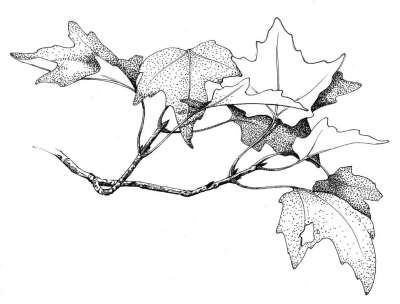
Autumn color comes to the foliage of Vermont and New Hampshire in early September, crescendos in mid-October, and fades by November. What causes this display of color? And why is New England’s foliage so brilliant?
Fall color actually starts during the lazy days of high summer. Subtly decreasing amounts of daylight trigger the beginning of nitrogen re-absorption from the leaves back into the tree’s woody tissue. We cannot see this process. We cannot hear it or feel it. It starts in July and by late September, more than half of each leaf’s nitrogen (and phosphorous) has been returned to the woody tissue, where it acts as an antifreeze for the tree and will provide an infusion of nutrients for early spring growth.
Cool September nights, meanwhile, stimulate cells at the base of each leaf stem, or petiole, to dry out. Just inside these cells a layer of tough, corky cells develops, stopping the flow of water into the leaf and stopping the export of carbohydrates and metabolic waste back to the tree.
With the flow of water staunched, the production of chlorophyll stops. Chlorophyll, the green pigment in leaves, is volatile. Sunlight destroys it. A constant supply of water up through the trunk and into each leaf is required for the tree to continue manufacturing chlorophyll. As the flow of water into each leaf is cut off, the leaves become less and less green. In a dry summer, this de-greening of leaves may be obvious much earlier than in a wet summer as trees simply run out of water to maintain full chlorophyll production.
With chlorophyll production winding down, previously unseen pigments appear. Xanthophylls, the yellow pigment in egg yolk and butter, and carotene, the orange pigment in carrots – both of which are present in varying amounts in different tree species all summer but hidden by chlorophyll – transform the leaves of American elm, quaking aspen, paper birch, and black willow to a golden yellow.
While autumn yellows are produced by subtraction, autumn reds are produced by addition – the addition of sugars and leaf waste which cannot exit through the plugged petioles. Anthocyanin yields the red of sumac, blueberry, red maple, and Virginia creeper, the purple-blue of white ash, and the purples of viburnum. If the leaf sap containing anthocyanin is acidic, leaves turn red. If the sap is alkaline, they turn blue or purple.
Anthocyanin is a sun pigment. If late September and October are overlaid with clouds, little anthocyanin is produced. Leaves go from green to yellow. Sunny days and cool nights, however, generate reds and oranges and purples. Don’t believe the tales about Jack Frost painting fall color across the Northeast. While a gentle nip may spur leaf petiole drying, a hard frost ruptures plant cells, causing their contents to leak out and destroying their brilliant color.
So why is New England foliage world-renowned for its brilliance? The sugar maple, of course. The same tree that makes sugaring a unique spring experience is also the key to fall foliage. Sugar maple leaves contain all three pigments – xanthophyll, carotene, and anthocyanin – and as go the sugar maples, so goes fall color. Sugar maple leaves turn yellow in the shade, red in the sun, and, depending on the proportion of sun and shade, and on genetics, they change hourly from yellow to red to orange. The red moves down from the top of the tree and in from the sides. The higher the content of sugar trapped in the leaves, the more brilliant the color. Each leaf has its own pattern. Yellow spreads from the leaf margins inward. Green retreats to the veins. Soon, the veins, too, turn yellow. Finally, the whole tree is orange, dusted with red, inlaid with yellow.
I’ve looked at enough Octobers in the West to know that their color pageant is not the same as ours. The genius of one sugar maple is worth an entire hillside of aspen. It’s like comparing Mozart to Manilow. Aspen is yellow, often yellow only, whereas sugar maple is moody, unpredictable, its colors an ephemeral reflection of the weather. They cannot be spoken. They’re too varied, too rich, too unstable.


Discussion *